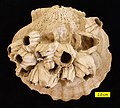Sclerobiont
Sclerobionts are collectively known as organisms living in or on any kind of hard substrate (Taylor and Wilson, 2003). A few examples of sclerobionts include bryozoans, and “Berenicea” bryozoans.
-
Entobia sponge borings and the cyclostome bryozoan Voigtopora thurni on an oyster valve from the Coon Creek Beds of the Ripley Formation (Upper Cretaceous) near Blue Springs, Mississippi.
-
Serpulid worms enrusting Pecten; Duck Harbor Beach on Cape Cod Bay, Wellfleet, Massachusetts.
-
barnacles and sponge borings (Entobia) from the Pliocene of York River, Virginia, USA.
See also
References
- Taylor, P. D.; Wilson, M. A. (2003). "Palaeoecology and evolution of marine hard substrate communities" (PDF). Earth-Science Reviews. 62 (1–2): 1–103. doi:10.1016/S0012-8252(02)00131-9. Archived from the original(PDF) on 2009-03-25.
Wikimedia Commons has media related to Bioerosion.





